An Tir Internal Letter for January, AS XXXX / 2006 CE
 |
Lady Richenda du Jardin, Lions Blood Herald |
- LETTERS FROM KINGDOM HERALDIC STAFF
- HERALDIC ARTICLES
- LAUREL ACTIONS
- LIONS BLOOD ACTIONS
- NEW SUBMISSIONS
Unto Christopher Black Lion and the esteemed members of the An Tir College of Heralds to whom this missive comes, Richenda du Jardin, Lions Blood Herald, sends greetings and felicitations.
COMMENTARY ON THE ITEMS IN THIS INTERNAL LETTER IS DUE ON THE 10TH OF MARCH.
The January Lions Blood meeting will be held January 22 (so as to not conflict with Coronation)at 1:00 at my house. I am looking for people to host meetings in February (19). The March (19) meeting will be held at Æthan of Eppylhurste’s place in Seattle — directions will be in the next Heralds’ Page.
Directions to my house are:
From the West: Take your best route to I-90. Get off on exit 280 (Lincoln Ave/Maple Ave.). Go through two lights and turn right at the next intersection (Jefferson). Go one block and turn left (Fifth). Turn right at the fourth stop sign (Howard). Follow Howard for two blocks — find whatever parking you can in the second block as parking is rather tight. Walk up to 7th and I am in the brick building on the left (524 W 7th.). Buzz apartment #510 and someone will be down to get you.
From the East: Take your best route to I-90. Get off on exit 280 (Lincoln Ave/Maple Ave.). Turn left at the second light (Second). Turn left at the second light (Fourth). Turn right at the next intersection (Jefferson). Go one block and turn left (Fifth). Turn right at the fourth stop sign (Howard). Follow Howard for two blocks — find whatever parking you can in the second block as parking is rather tight. Walk up to 7th and I am in the brick building on the left (524 W 7th.). Buzz apartment #510 and someone will be down to get you.
Limited crash space will be available.
LETTERS FROM KINGDOM HERALDIC STAFF
From Lions Blood
The holidays are over. The time has come for us to begin planning for the upcoming tourney season. I plan to be at several kingdom events (TBD) and will be available to answer questions about decisions and the submissions process. Please feel free to stop by and say hi.
I want to thank the following people for the helpful commentary for the December meeting: Lí Ban ingen Echtigeirn, Boar; Juliana de Luna, Siren; GUNNVOR; Æthan of Eppelhyrste; Esclarmonde de Porcairages, Argent Scroll; Talan Gwynek, Fause Losenge; Alicia le Wilfulle, False Isle; and Ursula Georges, Loyalle. These people do a tremendous amount of unseen work for our submitters.
I have been running into one minor problem when trying to contact submitters — some submitters have moved between the time their submissions were sent in and the time the final decision is made. Occassionally this time frame exceeds the automatic forwarding period that the US and Canadian postal services allow. Please tell your submitters to send updated contact information to me so they can get their notifications (or answer questions). Ask them to include the approximate time they send in their submission, their SCA or submitted name and their updated contact information (including a phone number and e-mail).
Likewise, if a group’s herald should change, please let me know ASAP so notifications can be send to the right person.
In service,
Richenda du Jardin
Lions Blood
richenda@cet.com
HERALDIC ARTICLES
Web Site Documentation
Documenting names from the web is not all that different than documenting names from a book. When you document a name from a web site, include the first page with the title and author’s name, then any pages that contain the information you are relying on — just as you would include the title page of a book and the pages that the information you refer to is on. You don’t have to send every page of the web site, just like you don’t have to photocopy the entire book. And, just as you include the copyright page of a book so we can find the book more easily, you need to ensure the complete URL is on the first (and preferably all) page of the web site documentation you send in.
To include the URL on the documentation, go to the Page Setup section. In Mozilla or Netscape, click the Margins & Header/Footer tab, then click the drop-down boxes then add the URL. In Internet Explorer, put the code &u in either the header or footer section of the page. Do not copy/paste web site information into a Word or other document.
LAUREL ACTIONS
The following items have been registered by Laurel.
-
Ailionóra inghean Tighearnaigh. Device.
Argent, on a bend engrailed azure between a brown horse rampant and a tree eradicated proper three gouttes argent. -
Alexander Petrovich. Reblazon of device.
Vert, a bear rampant maintaining a sword and on a chief Or a quill pen its nib to dexter vert.
Originally registered 10/1999 and blazoned as Vert, a bear rampant maintaining a sword and on a chief Or a quill pen nib to dexter vert, the tertiary charge is a quill pen, not a quill pen nib. - Azemar de Lyon. Name.
-
Bacchus of Ambergard. Holding name and device (see RETURNS for name).
Gules, a heron rising wings displayed and on a base argent a comet fesswise gules.
Submitted under the name Bacchus Magnus. -
Bláthnait of Grimwith. Name and device.
Argent, a ram rampant gules and on a chief rayonny sable two pairs of arrows inverted in saltire argent.
Originally submitted as Bláthnaid of Grimwith_, the given name was changed at kingdom to Bláthnat of Grimwithshire to match the Old/Middle Irish citation found for this name in Ó Corrain and Maguire, Irish Names. The byname was changed at kingdom to match the registered name of the shire. Ó Corrain and Maguire note Bláithnait, as the Early Modern Irish form of this name; this is closer to the submitter's original form than Bláthnat. Furthermore, either Grimwith or Grimwithshire are registerable as locative bynames. No examples of English placenames have been found using the element shire where the substantive element could not stand on its own as an independent placename. While there is no actual placename called Grimwith, Mills, A Dictionary of English Placenames show numerous examples of the protheme Grim- and of the deuterotheme -with, so Grimwith is a perfectly valid constructed English placename. Because the submitter's form shows of Grimwith on the name line and Grimwithshire on the group line, we believe that the submitter desired the form she submitted instead of the actual group name. Therefore, we have changed the name to Bláthnait of Grimwith_ to allow a form closer to the one originally submitted.
There was some question whether the names Bláthnat and Bláthnait were registerable; ó Corrain and Maguire cite it only as a legendary name. However, they note that it is a diminutive of the name Bláth which is documented as a saint's name. Because adding -nat or -nait is a standard way to form feminine Gaelic diminutives, this name is a well formed diminutive of a registerable given name. Therefore, it is, itself, registerable.
Please advise the submitter to draw the arrows thicker. - Caesaria Beribroun. Name (see RETURNS for device).
-
Casse Tempeste. Name change from Casse Tempeste le Wolf.
Her old name, Casse Tempeste le Wolf, is released. -
Ciarmhac Ó Ceallaigh. Name and device.
Azure, a tower argent and overall two enfields combatant Or.
The submitter requested authenticity for 15th-16th C Irish Gaelic. While this is a fully Early Modern Gaelic form of this name, there is no evidence for the use of the name Ciarmhac as a given name after the 10th C. Therefore, we are unable to make this name authentic for the submitter's requested time frame. If the submitter is interested in an authentic 10th C version of this name, we suggest the Middle Irish form Cairmac h-úa Cellaig; h-úa Cellaig appears in the "Annals of Tigernach" in the entry for 1028. -
Duncan MacDuff. Badge.
Azure, a dance ermine between a hart's head cabossed and two escallops Or.
Please advise the submitter that the dance should be centered on the field. -
Elizabeth Little. Name and device.
Purpure scaly argent.
Scaly is considered a field treatment and, per the Glossary of Terms, a field treatment is part of the tincture. As used in the SCA, <X> scaly <Y> and <Y> scaly <X> are not interchangeable. For comparison, consider papellony, which is discussed in the 09/2002 Cover Letter.
This is thus clear under RfS X.4.a.ii(b) (complete change of tincture) of Trimaris; Order of the Argent Scales (June 1995): Argent scaly azure -- much as Argent ermined azure would be clear of Azure ermined argent. The two are considered distinct tinctures. -
Gabriele Silverhand. Device.
Per pale gules and vert all semy of musical notes Or, a hand and a chief argent.
Please advise the submitter to draw the chief wider. -
Guy Grímsson. Name and device.
Argent, a Latin cross formy vert and on a chief enarched azure a hammer reversed Or.
Guy is the submitter's legal given name.
The submitter requested a name authentic for someone "born French Norman; raised Norwegian 10th-11-th century." The byname is a lovely Viking byname, but we have no documentation for the name Guy and none on how names used by people with the submitter's persona story might be formed. Therefore, we doubt that this name is or can be made authentic for the circumstances requested by the submitter.
Please advise the submitter that the lower arm of the cross should be somewhat longer for a true Latin cross. -
Halla Hrafnsdóttir. Name and device.
Argent, two natural panthers salient addorsed sable and a base urdy vert. -
Johannes von Morgarten. Name change from holding name Johannes of Midhaven.
Submitted as Johannes von Margarten, the submitter requested authentcity for the 12-15th C. The documentation submitted for Margarten was a map of the Swiss confederation; unfortunately, the map was somewhat out of focus, and could show Morgarten or Margarten. A search of Registra Imperii (http://registra-imperii.uni-giessen.de) shows eight examples of Morgarten in the submitter's desired period and none of Margarten. Although the Registrii Imperii does normalize the spellings, this still strongly suggests that Morgarten is the appropriate form. Therefore, we have changed the spelling to Johannes von Morgarten to match the available documentation.
[URL cited above does not work - Online IL Editor] -
Julia Sempronia. Name and device.
Gules, a ram couchant contourny reguardant Or.
Submitted as Julilla Sempronia, we have no examples of Roman names where, when a nomen or cognomen to which the feminine diminutives -illa or -ina has been applied is found, it is the first element in a two element name. All the examples we have found show either the diminutive as the second nomen or cognomen in a two part name with the first nomen as the standard femininized non-diminutive form, or we have found the woman called only by a single name: the diminutive of the nomen. Barring documentation for such a pattern, names following this pattern are not registerable. We note, however, that we only have a small pool of Roman women's names available; it is possible that this pattern may be found. We have changed the name to Julia Sempronia in order to register it. We note that Sempronia Julilla would also be registerable, but we feel that switching the order of the names is a major change which the submitter will not accept. We also would expect that a woman with the name of Julia Sempronia might reasonably have been called Julilla when referred to by a single name.
Several commenters questioned whether the form Julilla was a valid feminine diminutive of the nomen Julius. While the submitter had demonstrated a pattern of diminutives ending in -illa formed from femininized nomen, the commenters were unsure whether the formation was valid with a nomen whose root ended in a vowel. In fact, examples of just this usage are not hard to find. "The Trial of C. Junius Silanus", by D. C. A. Shotter, Classical Philology © 1972 The University of Chicago Press, lists a Junia Claudilla in AD 28; Claudilla is a feminine diminutive of the nomen Claudius. Junia Claudilla is a wife of the Emperor Caligula; several other journals have references to her by this name. "A Hoard of Coins Found in the Theatre District of Corinth in 1930", by Theodore Leslie Shear, American Journal of Archaeology © 1931 Archaeological Institute of America , has Plautilla in 211 from the nomen Plautius (the names on the coins are Greek, but this is the standard Roman transcription of the inscription). "The Amphitheatre in Cagliari", by Doro Levi, American Journal of Archaeology © 1942 Archaeological Institute of America, lists a Curilla in 275 from the nomen Curius. -
Mughain inghean Donnghaile. Device.
Argent, on a pale endorsed vert between two irises purpure slipped and leaved vert a swept-hilt rapier proper.
Blazoned on the LoI as lilies, the flowers in this submission do not match the defined heraldic form of a lily. We have reblazoned the flowers as irises, which are drawn more naturalistically.
Please advise the submitter that the entire hilt of the rapier should be Or. -
Ninian of Warwick. Device.
Purpure, an owl Or within a bordure ermine.
This does not conflict with Christopher Amber, Purpure, a penguin close Or. There is a CD for adding the bordure and another for the difference between an owl and a penguin. -
Richard mac Tighearnaigh. Name and device.
Argent, in pale an elephant statant contourny sable and a tree eradicated proper within a bordure embattled sable.
This name mixes English and Gaelic; this is one step from period practice. -
Ríoghnach of Ruantallan. Badge (see RETURNS for name change).
(Fieldless) A fly per pall argent, gules and vert. -
Swan the Red. Badge.
(Fieldless) A Wake knot palewise Or.
There was a question on the correct orientation of the Wake badge which is currently protected, (Tinctureless) A Wake knot. A Wake knot is fesswise by default; therefore that is the orientation in which it is protected. We have no examples of the Wake knot in multiple orientations in the Wake badge. Until we are presented such evidence we will continue to grant a CD for orientation of this knot. -
Symmonne Deccarrete de Villette. Name correction from Symmonne Deccarrette de Villette.
In August 2004, Symmonne requested that her alternative name, Symmonne Deccarrete de Villete, and primary name, Darbie of Ironmaid be switched and that the spelling be changed to Symmonne Deccarrete de Villette. A typo was introduced in the letter of intent, and her new primary name was listed as Symmonne Deccarrette de Villette, which was registered on the LoI. However, the desired and correct spelling for this name is Symmonne Deccarrete de Villette.
The previously registered primary name, Symmone Deccarrette de Villette, is released. -
Una of Grimwith. Name and device.
Per bend sinister wavy argent and sable, a bend sinister wavy between a horse rampant to sinister and a chalice counterchanged.
Originally submitted as Una of Grimwith_, the name was changed at kingdom to Una of Grimwithshire to match the submitter's group name. Either Grimwith or Grimwithshire are registerable as locative bynames. No examples of English placenames have been found using the element shire where the substantive element could not stand on its own as an independent placename. While there is no actual placename called Grimwith, Mills, A Dictionary of English Placenames show numerous examples of the protheme Grim- and of the deuterotheme -with, so Grimwith is a perfectly valid contructed English placename. Because the submitter's form shows of Grimwith on the name line and Grimwithshire on the group line, we believe that the submitter desired the form she submitted instead of the actual group name. Therefore, we have changed the name back to the originally submitted form. -
Uther Ainsheasccar. Name and device.
Per bend sinister sable and argent, a bend sinister Or between a moon in her plenitude and a bear rampant counterchanged.
This name mixes English and Gaelic; this is one step from period practice.
Please advise the submitter to draw the bend sinister wider. -
Yngvildr {O,}gursdóttir. Name and device.
Azure, on a cross argent a trefoil vert, overall a bordure counterchanged.
Submitted as Yngvildr Ögursdóttir, the Ö in the cited source is a character intended to represent the O-ogonek. For registration, we transliterate this character as {O,}. We have made this change. -
Ysolt Tayler of Windhill. Name and device.
Argent, two chevronels braced gules and in base a rose, a bordure sable.
There was some question whether the spelling Tayler was registerable, since the earliest date cited for this spelling in the documentation was 1790. However, the OED shows Tayler in 1545 and Taylere in the 15th C. Therefore, the spelling is registerable.
The following items have been returned for further work.
-
Aodagán Duueglas. Name and device.
Argent, a chevron wavy vert and in base a fir tree eradicated azure.
This name has several problems. Even after we resolve one major problem we are able to fix, the name is two steps from period practice. First, the spelling of the given name is modern. This spelling was documented from Woulfe, Irish Names and Surnames, from the section that cross-references modern Irish given names with their modern English equivalents. Although Woulfe has a listing for Mac Aodhghan, use in a patronymic style surname, especially in Ireland where surnames were adopted relatively early, is not proof that a particular given name remained in use. Luckily, the name is found in period in the spellings Aeducan (in documents that use Middle Irish orthography) and Aodhogan (in documents that use Early Modern Irish orthography). However, this leads to the second problem -- the latest date the commenters were able to find where the given name is used as a given name (as opposed to a byname) is the mid 9th C. The earliest date found for the locative byname is the mid 13th C. Therefore, there is a temporal gap of more than 300 years between the dates for the two names, which is a step from period practice. In addition, the name mixes Gaelic and Anglo-Norman, which is also one step from period practice. As we are unable to either find an Anglicized version of the given name or a Gaelic version of the byname, or a version of the byname dated before the 13th C, we are unable to make the name registerable.
This device is returned for a redraw. The chevron is not wavy enough and at any distance it appears to be a plain chevron. The tree could be drawn smaller to allow the chevron to be drawn wider.
The tree is nicely eradicated. -
Bacchus Magnus. Name.
This name is presumptuous of Bacchus, Roman God of wine. Taken together, the name may be translated as "Great Bacchus." While each part of the name may be found as a given name used by humans, the combination of the two makes too strong a suggestion of divinity.
The device was registered under the holding name Bacchus of Ambergard. -
Caesaria Beribroun. Device.
"Azure", two domestic cats rampant guardant in saltire Or.
The "azure" is neither blue nor purple, which is grounds for return. Even if the tincture of the field had not been a problem, this would have been returned for conflict with Jerimia von Braun, Azure, two domestic cats sejant respectant, tails sufflexed and crossed in saltire, Or. There is a single CD for changing the posture of the cats. It also conflicts with Leonus de Rotund, reblazoned elsewhere in this letter as Azure, in saltire a cartouche voided and a lion salient contourny queue-fourchy, the lion passing through the cartouche, all Or. Leonus's device is a lion jumping through a hoop that is bendwise; the lion and the cartouche are co-primary. There is a single CD for changing the cartouche to a lion. -
Ruaidhrí Lámgel. Device.
Per pale embattled gules and vert, an open book Or and a gauntlet aversant, a chief argent.
This is being returned for a redraw. The book should not touch the line of division as that affects the identifiability of both the charge and the line of division. The line of division is not properly drawn; it seems to start as a straight Per pale where it issues from chief and base, and then becomes Per pale embattled about one crenellation into the shield. And, as mentioned in the previous return, the chief should be drawn wider. While any one of these problems alone may not be cause for return, when combined they are enough to require a redraw. -
Theocharista Irene Doukaina. Name change from Ríoghnach of Ruantallan.
No evidence was submitted and none found for double-given names in Byzantine naming practice. Barring such evidence, double-given names in Byzantine names are not registerable. We would drop one of the given names to register this name, but the submitter will not accept major changes.
The following items were corrected by Laurel
-
Caitrina inghean Aindriasa. — Name correction from Caitrina inghean Anndrais.
(Fieldless) In pale a mouse statant argent tail threading a needle fesswise sable.
Listed on the LoAR as Caitrina inghean Anndrais. Her name was registered as Caitrina inghean Aindriasa in August 2004. -
Kára Bjarnardóttir. — Name correction from Kara Bjornsdottir.
Quarterly Or semy of roses purpure and purpure, a swan contourny argent within a border quarterly purpure and Or semy of roses purpure.
Listed on the LoAR as Kara Bjornsdottir. Her name was registered as Kára Bjarnardóttir on the September 2003 LoAR. -
Lia da Firenze. — Return of name.
The submitter withdrew the name via a timely letter of correction. We consider a withdrawal to be equivalent to a return: as with a return, if the client submits another name, it should be listed as a resubmission. -
Uilliam mac Ailéne mhic Seamuis. — Alternate name William the Mariner.
The LoAR incorrectly said that his old name, William the Mariner, was released. It is being retained as an alternate name. -
Ysoria de Brai. — Blazon correction.
(Fieldless) A pair of barnacles argent.
The LoAR misspelled the word as Fieldess.
LIONS BLOOD ACTIONS
These items will be forwarded to Laurel
-
Alexander Selyngier — Name, New and Device, New.
Per chevron azure and sable, two tygers and a dragon argent
Documentary forms of names are registerable in most circumstances. -
Antoine Le Gallic — Name, New.
The College of Heralds was unable to find Le Gallic as a period documented form. However, Sara L. Uckelman's "French Names from Chastenay, 1448-1457" (http://www.ellipsis.cx/~liana/names/french/chastenay.html) has <Denis le Gallois> in 1449. In addition, Morlet, Dictionnaire Étymologique des Noms de Famille, s.n. Gall, discusses Gall first as an ancient patronymic from the Latin name Gallus, then as an undated locative indicating someone from France (in Breton). She goes on to list the diminutive forms Gallic and Le Gallic. The Catholic Encyclopedia, s.n. Saint-Sulpice (http://www.newadvent.org/cathen/13378a.htm) provides a citation of the name to the 18th century (Pierre Le Gallic, 1777-82). Le Gallic does not appear to be a totally implausible surname. -
Danescombe, Shire of — Badge, New.
(Fieldless) A yale head erased contourny gules -
Drosten Sutherland — Name, New and Device, New.
Gules, a fishhook reversed Or banded sable within a bordure per pale sable and argent
Drosten is found in Black, Surnames of Scotland, sn Drostan. Black indicates Drostan was the saint to whom the Abbey of Deer was dedicated. Black states “the name also occurs on the St. Vigeans stone (8th century) near Arbroath as Drosten.” As a saint’s name, this name should be free of temporal incompatibility issues. -
Fionnghuala inghean Lochlainn — Name, New.
The name as spelled in the Internal letter, Fionghuala inghean Lochlainn, was incorrect. The correct spelling of the name is Fionnghuala inghean Lochlainn. -
Gwyneth Gower — Name, New.
The Academy of St. Gabriel report #2022 states “The first examples of the Welsh name <Gwyneth> that we found were in the late 16th and early 17th centuries: Gwineth 1577, Gwenett 1629, Gwinne 1630.” Tangwystyl verch Morgant Glasvryn “A Simple Guide to Constructing 16th Century Welsh Names (in English Contexts)” (http://www.s-gabriel.org/names/tangwystyl/welsh16.html) dates gives modern <Gwyn> as <Win>, <Wyn>, <Gwin>, and <Gwyn>. Given the interchangeability of the y and i in these spellings, “Gwyneth” seems to be a plausible spelling for our period. -
Ieuan Gower — Name, New and Device, New.
Sable, an ostrich feather between in bend sinister two mullets Or
The An Tir College of Heralds raised a question as to the item at the base of the plume. It could be a pen base, if so, this charge may be better blazoned as a quill pen. This was forwarded for Wreath to make the determination. -
Inga Hraustlig — Name, New.
Originally submitted as Inga in Hrastliga, the surname name was changed match the documentation provided by the commenters. The change from Inga in Hraustliga to Inga Hraustlig was the smallest change available.
According to GUNNVOR:“<Hraustliga> is wrong - that's the adverb. The Old Norse adjective <hraustligr> is a grammatically strong comparative adjective meaning "bold, valiant, manly". As Geirr Bassi explains on p. 19 in regard to adjectives used as bynames, "The weak endings may be used without the article, but the strong adjective always appears without it." I am not at all sure how <ligr> changes in the feminine. Usually you'd just drop the <-r>, which would give you <hraustlig> as the feminine, needing no definite article. That "manly" meaning makes me doubt this word as a great choice for a woman's byname, however.
“<Hraustr>, on the other hand, might be a much better choice. It's the strong adjective for "strong, valiant, doughty", and we know it can be used of a woman, as Cleasby & Vigfusson give the example "var hon ?a enn hraust kona" [she was a strong woman] from Isl. ii. 453 and "hraust kona" from Svarfdala saga 150.
“See:
“Cleasby, Richard and Gu?brandr Vigfusson. An Icelandic-English Dictionary. 2nd ed. Oxford: Clarendon. 1957. From http://www.ling.upenn.edu/~kurisuto/germanic/oi_cleasbyvigfusson_about.html p. 282 s.vv. <hraustligr>, <hraustr>.
“Summary: I'd recommend <Inga hraust> as the best choice, or maybe <Inga hraustlig> (assuming that's the correct feminine for an adjective ending in <-ligr>).”
“Since then, I consulted with Master Talan Gwynek, who confirmed that indeed, for the masculine adjective <hraustligr>, the correct feminine form is <hraustlig>. Either way, as explained above, both are strong adjectives and therefore you don't use the definite object <in> or <inn> (or <hin> or <hinn>) with them. -
Kassandra of Dragon’s Laire — Device, New.
Per chevron argent and vert in chief a pair of lace bobbins crossed proper, in base a closed book proper - Lucian de Brus — Name, New.
-
Magnus inn Tōrshavn — Name, Resubmission and Device, Resubmission.
Gules, a crab argent, within a border argent
Inn Tōrshavn is not the correct form of the byname meaning “from Tōrshavn;” instead it means “the Tōrshavn.” This has been forwarded to Laurel for Pelican to determine the correct form of the byname. - Nicole La Bergère — Name, New.
-
Piera Sartore — Name, New and Device, New.
Per pale azure and vert a fox mask argent and on a chief Or a roundel between an increscent and a decrescent sable -
Rasmus Ravnssen — Name, New and Device, New.
Gyronny gules and Or, a raven reguardant contourny and an orle sable - Robert Conyers — Name Change from Hobbe de Conyers, New
-
Solveig Tryggvadottir — Badge Change, New.
(Fieldless) a Norse comb Or
The submitter provided several pages of documentation of the comb style depicted in her badge. This badge is clear of Morgana of the Crystal Wells, April 1986, Per pale azure and argent, a hair comb counterchanged. There is 1 CD for the change of the field from per pale azure and argent to fieldless. There is a second CD for the change of tincture of the comb from per pale argent and azure to Or. The phrase counterchanged is simply shorthand for use the tinctures of the field and reverse onto the charge.
The Or of this comb is barely acceptable as it was colored in with a highlighter. Fortunately, the highlighter is not of too neon a color. -
Úna Fhionn inghean Mhic Fhionnghaile — Name, New
The Internal Letter incorrectly spelled inghean as inghenn. The typo has been corrected. - Vikarr Vikingsson — Name, New.
These items are being returned for further work
-
Áine inghean uí Steele — Name, New and Device, New.
Sable, two chevronels and in chief an arrow fesswise argent
The phrase inghean ui is used to indicate a clan affiliation or a familial relationship with another person. Because Steele is neither a clan name nor a man’s name in Gaelic and the submitter allowed no major changes, this name is being returned. Many commenters pointed out that Áine Steele would be a perfectly registerable name.
Because the submitter’s name was returned, the device must also be returned.
This device is clear of Dmitrii of Seagirt, September 2001, Sable, in pale a winged serpent displayed and two chevronels argent. The winged serpent of Dmitrii’s device is a co-primary charge with the chevronels. The arrow in chief on this submission has significantly less visual weight than the chevronels and is significantly displaced to chief. Therefore, it is a secondary charge not part of the primary charge group. Therefore, there is 1 CD for change of number of primary charges and 1 CD for the addition of the secondary arrow.
Under certain circumstances, when a device is completely black and white, “full-color” copies of the device may be substituted for the line drawing (i.e., the submitter may send six copies of the black-and-white instead of three color and three line drawings). In general this is only acceptable when the charges are black and the field is white, because important internal detailing may be lost when commenters try to color the mini-emblazon. However, in this case, the detailing of the long, thin arrow in chief could be lost when commenters try to color the mini-emblazon.
The submitter should be aware that the pixilation of the device is barely acceptable. This is often a problem with computer-generated graphics, particularly when they are blown up to the size required for the emblazon. -
Antoine Le Gallic — Device, New.
Per bend sinister azure and Or, a compass star between four compass stars Or and a compass star between four compass stars azure
This device is being returned for violating the precedent against using the same charge in a primary and a secondary charge group (aka Sword and Dagger rule). Per Dame Elspeth Anne Roth:[an octofoil within eight octofoils in annulo] Size is not the only thing that determines a primary charge. We were unable to devise a way to describe arrangement of the charges in a way that did not imply that they were a primary charge surrounded by a secondary group. Such arrangements cannot use the same type of charge. The problem could be solved by arranging them in a diamond (1,2,3,2, and 1) or in a square (3,3, and 3). [Yin Mei Li, 09/00, R-Artemisia]
In addition, this device violates RfS VIII.3 Armorial Identifiability. Some of the charges resemble mullets and others appear to be compass stars. As a note to the submitter, a compass star is an out-of-period variant of a mullet, so surrounding a compass star with mullets (or vice versa) does not fix the violation of precedent against using the same charge in both a primary and secondary charge group. -
Gwyneth Gower — Device, New.
Plumetty vert and Or, on a chief triangular sable, an acorn slipped and leaved Or
While the submitter sent a letter explaining that she intended the acorn to be on a chief triangular and not on a per chevron inverted field, this device must still be returned. The chief triangular is drawn too far down the field to be a chief, but is not far enough down the field to be per chevron inverted. As a result, it blurs the distinction between the two and is in violation of RfS VIII.3 Armorial Identifiability.
To correct the error, a chief triangular should extend no further down the field than half way between top two pairs of tick marks (at the chief line and the per fess line). -
Inga Hraustlig — Device, New.
Per pale gules and vert, on a chief indented or, a dog couchant sable, gorged of a collar argent
This device is being returned for two reasons. The first reason is that the dog on the chief is in an unblazonable posture. It is neither courant nor passant. The front two legs are in a courant position and the back two legs are in a passant position. However, neither position has the curve to the back as this charge has. The closest posture that any commenters could find was s’elogeant, a posture which has been disallowed for some time.
The second reason is the tincture of the device has changed over time. The Or of the chief is much more like tenne, a non-period tincture. Unfortunately, this is a common problem with computer-printed armory as printer inks are notoriously uncolorfast. -
Sigelhundas, Shire of — Badge, Resubmission.
(Fieldless) On a sun azure, a talbot salient argent
This badge is being returned for multiple conflicts.- Solveig Throndardottir, October 1992, (Fieldless) A sun azure eclipsed argent.
There is 1 CD for the fieldlessness of each badge. The sun is not simple enough to void. Per RfS X.4.j Changes to Charges on Charges, the tertiary requires changes to two of the following: type, number, tincture, posture, or arrangement. There is not a second CD for the tertiary as only the type of the tertiary was changed. - Lorimer MacAltin of Garioch, May 1983, Argent, on a compass star azure a thistle couped argent.
There is 1 CD for change from argent to fieldless.
By longstanding precedent there is not a CD between a sun and a compass star, so there is no CD for the change of primary charge. The sun is not simple enough to void. Per RfS X.4.j Changes to Charges on Charges, the tertiary requires changes to two of the following: type, number, tincture, posture, or arrangement. There is not a second CD for the tertiary as only the type of the tertiary was changed.
- Astra Christiana Benedict, June 1982, (Tinctureless) On a mullet a cross crosslet.
There is 1 CD for the fieldlessness of each badge. There is a second CD for the difference between a mullet and a sun. Per Dame Elspeth Anne Roth:[suns vs. mullets]... as suns and mullets are not substantially [different], there is nothing for changing the type only of the tertiaries. [Ursella of Rowantree, 11/99, R-Caid]
This statement implies that suns and mullets are significantly different, which is worth a CD. If they were substantially different, they would be clear by X.2. - Adrienne de Champagne, January 1990, Argent, on a mullet of six points azure, a falcon displayed argent.
There is 1 CD for the fieldlessness of each badge.
There is no CD for either the change from six-pointed mullet to sun. Per Master François la Flamme:[a sun vs. a mullet of seven points] By current precedent there is not a CD between a multi-pointed mullet and sun... [Máire MacPharthláin, 02/02, R-Calontir]
A standard mullet has five-point and is not considered “multi-pointed.” There is no CD between Adrienne’s six-pointed mullet and Sigelhundas’ sun.
The sun is not simple enough to void. Per RfS X.4.j Changes to Charges on Charges, the tertiary requires changes to two of the following: type, number, tincture, posture, or arrangement. There is a second CD, however, for the changes of type and posture of the tertiaries. The tertiary charge was changed from a falcon to a talbot. Falcons do not have to be affronty (displayed is a posture that faces the viewer) nor do talbots need to be in a profile posture (salient is a posture that shows the profile of the critter. Per Master François la Flamme:[Azure, a fess between two greyhounds courant and a spiral hunting horn Or] This is clear of the arms of de la Pole, Azure, a fess between three leopard's faces Or (important non-SCA armory). There is one CD for changing the type of secondary charges. There is another for changing the orientation of the upper half of the charge group. Leopard's heads do not have to be affronty; they can be in profile. Greyhounds can be in an affronty posture. Therefore, per the following precedent, there is a posture CD.
[Purpure, a bend sinister between two falcons rising wings addored Or] This is clear of ... Purpure, a bend sinister between two glaive heads addorsed Or; for the type of secondaries, as well as a CD for orientation. (This CD is granted because both charges have the ability to be addorsed, and the falcons are not.)(LoAR 9/00)
[James of Leycester, 10/01, A-Meridies] - Brian O'Seachnasaigh (for House of the Golden Talon), September 1990, (Fieldless) A compass star azure charged with a griffin segreant reguardant Or maintaining a wavy-bladed sword fesswise proper
There is 1 CD for the fieldlessness of both charges. There is a second CD for the change of type and posture of the tertiary charge.
- Solveig Throndardottir, October 1992, (Fieldless) A sun azure eclipsed argent.
-
Sylva Silfri — Name, New and Device, New.
Sable, a flame between two flaunches argent
This name is being returned for lack of documentation. The web site provided by the submitter is the only location where St. Silva (as opposed to St. Silvia) appears. It is more than likely that this is a typographical error. Unless documentation from a standard and reliable source (such as either of the saint’s dictionaries used as the web site’s sources, or other saint’s dictionaries) can be presented supporting this spelling, it is unlikely to be registerable.
Because the name was returned, the device must be returned. -
Talentus Artiglio del Fero — Name, New and Device, New.
Per pall argent, sable and purpure, three claws sable argent and argent
This name is being returned for lack of evidence that Artiglio was used as a name in period Italy.
Because the name was returned, the device must be returned. In addition, the charges on the devices were unrecognizable; the commenters made several guesses. If these charges were intended to be a cant on the intended name of the submitter, then the claws should be drawn more distinctly. Claws were seldom, if ever found alone as charges; more typically, they were part of a jambe or foot. -
Vikarr Vikingsson — Device, New.
Purpure, a lion rampant contourny queue-forchy, within a orle of chain Or
This device is being returned because the tincture of the device has changed over time. The Or of the device is much more like tenne, a non-period tincture. Unfortunately, this is a common problem with computer-printed armory as printer inks are notoriously uncolorfast.
NEW SUBMISSIONS
To be ruled on at the March Lions Blood Meeting.
| 1. Amy verch Rychard | Wyewood | Name and Device, New |
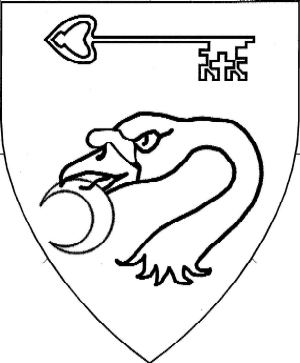 |
Gules, a swan’s head erased Or beaked sable maintaining in its beak an increscent in chief a key fesswise reversed wards to base argent The submitter will accept minor changes only, cares most about language/culture (unspecified), desires a female name, wants her name changed to be authentic for 14th century Welsh and will accept a holding name. The submitter refers to a letter from St. Gabriel, but includes no header information or letter number, to document her name to period. The letter in question dates Amy to the 16th century, but posits its use in the 14th and 15th centuries in Wales, It gives the Welsh patronymic of Richard as Rychard and dates it to 1460. | |
| 2. Amy verch Rychard | Wyewood | Badge, New |
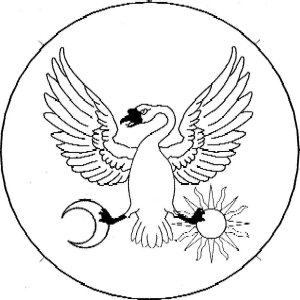 |
Gules, a swan displayed maintaining in dexter claw a sun Or and in sinister claw a decrescent argent | |
| 3. Arion the Wanderer | Dragons Laire | Name and Device, New |
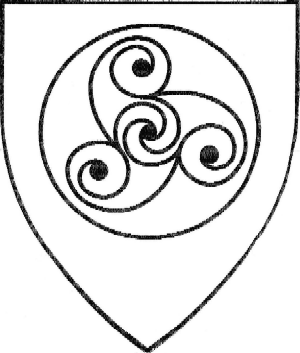 |
Azure, in an annulet Or, a triskeles Or, tipped by three spiral arms The submitter will accept no changes to his name, does not indicate whether he prefers meaning/sound/language/culture, desires a male name, and wants his name to be changed to be authentic for Greek 400BC. Arion can be found in Herodotus’ History in the Internet Classics Archive (http://classics.mit.edu/Herodotus/history.1.i.html). It states that Airon lived in Corinth under King Periander’s rule (625-585 BC) and was the best lyre player of his time. The submitter asserts that the Wanderer is a descriptive epithet and that descriptive epithets (such as Alexander the Great) were used in this time period. The “triskele” is blue; the lines that are black on the mini are golden on the color emblazon. The submitter included documentation of the artistic motif. | |
| 4. Arion the Wanderer | Dragons Laire | Badge, New |
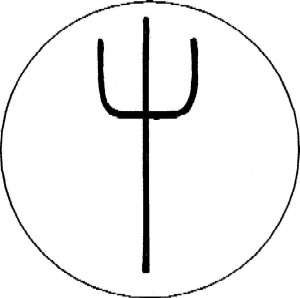 |
Argent, a trident sable The submitter’s name is on this letter. | |
| 5. Cerridwen of Conwy | Device, Resubmission | |
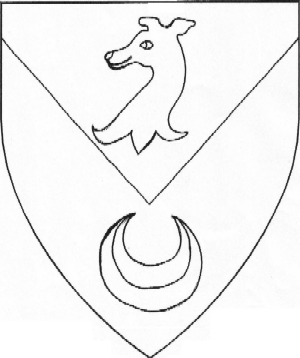 |
Per chevron Or and azure, a greyhound head erased and a cresent counterchanged The submitter’s name was registered in November 2004. The submitter’s previous device submission, Per chevron azure and Or, an increscent and a decrescent Or and a raven volant bendwise sable, was returned in March 2004 for conflict. This is a complete redesign. | |
| 6. Cristobal de Corrales | Aquaterra | Name and Device, New |
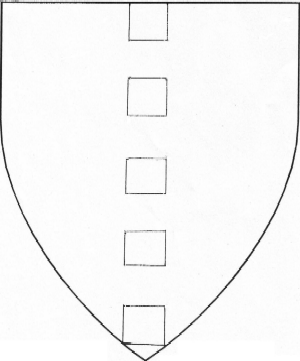 |
Azure, five delfs in pale or The submitter will accept any changes, cares most about sound, desires a male name, and wants his name changed to be authentic for 15th century Spain. Cristobal is documented from Juliana de Luna’s “Spanish Names from the Late 15th Century” (http://www.s-gabriel.org/names/juliana/isabella/MensGivenAlpha.html), s.n. Cristoval. However, the “copy” of this documentation was not a printout from the web site; it was copied/pasted into a word processor, then printed. de Corrales is documented from Juliana de Luna’s “Spanish Names from the Late 15th Century” (http://www.s-gabriel.org/names/juliana/isabella/locative.html). However, the “copy” of this documentation was not a printout from the web site; it was copied/pasted into a word processor, then printed. | |
| 7. Cristobal de Corrales | Aquaterra | Badge, New |
 |
a delf Or The submitter’s name is on this letter. | |
| 8. Mirien la Texedora | Madrone | Name, New |
|
The submitter will accept any changes, cares most about meaning (weaver), desires a female name, wants her name changed to be authentic for 12th-14th century Spain (Oh, Siren…) and will accept a holding name.
Mirien can be found in Julie Stampinski’s “Jewish Women’s Names in Navarra” (http//www.yucs.org/~jules/names/navarra.html), s.n. Miriam. This spelling is dated to 1285. Copies were provided. No documentation was provided for Texedora. | ||
| 9. Morgan ap Hugh | Sigelhundas | Name and Device, New |
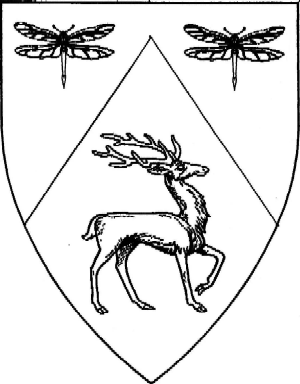 |
Argent, on a pile inverted gules between two dragonflies purpure a stag statant contourny Or The submitter will accept no changes, does not indicates what he cares most about, desires a male name, wants his name changed to be authentic for 16th century Welsh and will allow a holding name. Morgan is documented from A History of Wales by John Davies. In this history, on page 166, a reference is made to Morgan leading the Welsh in an revolt in 1294. Hugh is documented from A History of Wales by John Davies. In this history, on page 105, a reference is made to Hugh the Fat capturing Gruffudd ap Cynan after the battle of Mynydd Carn. | |
| 10. Palladius Hibernia | Aquaterra | Name and Device, New |
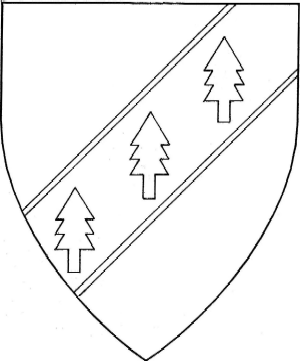 |
Or, on a bend sinister voided, three fir trees palewise vert The submitter will accept any changes, cares most about language/culture (Byzantine Roman), desires a male name, is not interested in authenticity and will accept a holding name.
Palladius can found at http://www.sca.org/heraldry/laurel/names/byzantine/plre_misc_names.html.
Hibernia is the Latin word for Ireland. A translation of the word was provided from the Catholic Archives (http://www.catholic.archives.nd.edu/cgi-bin/lookdown.pl?Ireland). Copies were provided. The bend is Or voided vert. | |
| 11. Timo der Schuzzelwanst | Wyewood | Name and Device, New |
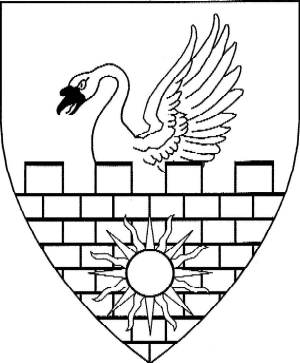 |
Per fess embattled gules and sable masoned argent, in pale a demi-swant rousant and a sun Or The submitter will not accept major changes, cares most about language/culture (unspecified), desires a male name, wants his name to be changed to be authentic for 14th-15th century Germany, and will allow a holding name. Timo can be found in Talan Gwynek’s “Medieval German Given Names from Silesia: Men’s Names” (http://www.s-gabriel.org/names/talan/bahlow/bahlowMasc.html). Talan dates Timo to 1316. However, the “copy” of this documentation was not a printout from the web site; it was copied/pasted into a word processor, then printed. der Schuzzelwanst is documented from Talan Gwynek’s “Some Early Middle High German Bynames with Emphasis on Names from the Bavarian Dialect Area” (http://www.s-gabriel.org/names/talan/Early_German_Bynames.html), s.n. Schüzzelwanst to 1190 as Schuzzilwenst, meaning bowl belly. The embattled lines are dark grey not argent. | |
| 12. Tir Rígh, Principality of | Badge Resubmission | |
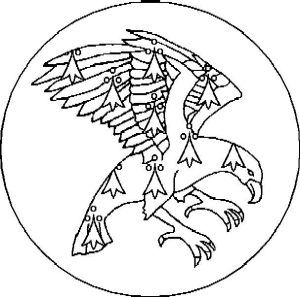 |
(Fieldless) A hawk striking to sinister erminois. This badge is to be associated with the Order of the Havoc. The submitter’s name was registered in November 2002. | |
| 13. Tir Rígh, Principality of, L’ordre de l’Etoile Argente | Order Name Resubmission | |
|
The submitter will accept any changes, does not indicate what they care most about, and is not interested in having the name changed for authenticity. This order name is believed to follow the color + thing construction described in Meradudd Cethin’s “Project Ordensnamen” (http://www.sca.org/heraldry/laurel/names/order/). In addition, the more precise pattern of metallic color + object is documented in Frederic Badger’s “A Collection of Period Order Names” ; (http://www.nwlink.com/~badger/sca/ordernames.html); the Gold Escutcheon from 1369 France is the exemplar (copies attached). However, no documentation of the use of the French word argent to describe non-metallic objects nor the use of the French word etoile were documented to period. | ||
| 14. Tir Rígh, Principality of, Order of the Red Flame | Order Name Resubmission | |
|
The submitter will accept any changes, does not indicate what they care most about, and is not interested in having the name changed for authenticity. This order name is believed to follow the color + thing construction described in Meradudd Cethin’s “Project Ordensnamen” (http://www.sca.org/heraldry/laurel/names/order/). In addition, the pattern of color + object is documented in Frederic Badger’s “A Collection of Period Order Names” ; (http://www.nwlink.com/~badger/sca/ordernames.html); the Gold Escutcheon from 1369 France is the exemplar (copies attached). However, no documentation of the use of the word red nor the word flame were documented to period much less the pattern of describing a flame by color. | ||
| 15. Tir Rígh, Principality of, Order of the Silver Pillar | Order Name Resubmission | |
|
The submitter will accept any changes, does not indicate what they care most about, and is not interested in having the name changed for authenticity. This order name is believed to follow the color + thing construction described in Meradudd Cethin’s “Project Ordensnamen” (http://www.sca.org/heraldry/laurel/names/order/). In addition, the more precise pattern of metallic color + object is documented in Frederic Badger’s “A Collection of Period Order Names” ; (http://www.nwlink.com/~badger/sca/ordernames.html); the Gold Escutcheon from 1369 France is the exemplar (copies attached). However, no documentation of the use of the word silver to describe non-metallic objects nor the use of the word pillar were documented to period. | ||
| 16. Tir Rígh, Principality of, Order of the Shattered Spear | Order Name Resubmission | |
|
The submitter will accept any changes, does not indicate what they care most about, and is not interested in having the name changed for authenticity. This order name is believed to follow the adjective + thing construction described in Meradudd Cethin’s “Project Ordensnamen” (http://www.sca.org/heraldry/laurel/names/order/). In addition, the pattern of past participle + object is documented in Frederic Badger’s “A Collection of Period Order Names” ; (http://www.nwlink.com/~badger/sca/ordernames.html); the Defeated Dragon from 1418 Germany is the exemplar (copies attached). However, no documentation of the use of the word shattered or spear were documented to period. | ||
In service,

Richenda du Jardin |

Uilliam mac Ailéne mhic Seamuis |